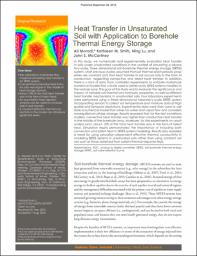
ATTENTION: The works hosted here are being migrated to a new repository that will consolidate resources, improve discoverability, and better show UTA's research impact on the global community. We will update authors as the migration progresses. Please see MavMatrix for more information.
Show simple item record
| dc.contributor.author | Moradi, Ali | |
| dc.contributor.author | Smits, Kathleen M. | |
| dc.contributor.author | Lu, Ning | |
| dc.contributor.author | McCartney, John S. | |
| dc.date.accessioned | 2021-05-28T18:43:28Z | |
| dc.date.available | 2021-05-28T18:43:28Z | |
| dc.date.issued | 2016-09-29 | |
| dc.identifier.issn | 1539-1663 | |
| dc.identifier.uri | http://hdl.handle.net/10106/29753 | |
| dc.description.abstract | **Please note that the full text is embargoed** ABSTRACT: In this study, we numerically and experimentally evaluated heat transfer in soils under unsaturated conditions in the context of simulating a laboratory-scale, three-dimensional soil-borehole thermal energy storage (SBTES) system. Most previous studies assumed that soil thermal and hydraulic properties are constant and that heat transfer in soil occurs only in the form of conduction, neglecting convective and latent heat transfer. In addition, there is a lack of data from controlled experiments to validate multiphase numerical models that can be used to better study SBTES systems installed in the vadose zone. The goal of this study was to evaluate the significance and
impact of variable soil thermal and hydraulic properties, as well as different heat transfer mechanisms, in unsaturated soils. Four laboratory experiments were performed using a three-dimensional laboratory-scale SBTES system, incorporating sensors to collect soil temperature and moisture data at high spatial and temporal resolutions. Experimental data were then used to validate a numerical model that solves for water and vapor flow and considers nonequilibrium phase change. Results revealed that for the test conditions studied, convective heat transfer was higher than conductive heat transfer in the middle of the borehole array. Moreover, for the experiments on unsaturated sand, about 10% of the total heat transfer was in the form of latent
heat. Simulation results demonstrated the importance of including both convection and latent heat in SBTES system modeling. Results also revealed a need for using saturation-dependent effective thermal conductivity in modeling SBTES systems in unsaturated soils rather than using constant values such as those obtained from system thermal response tests. [© Soil Science Society of America. This is an open access article distributed under the CC BY-NC-ND license (http://creativecommons.org/licenses/by-nc-nd/4.0/). This is a published version of an article published in Vadose Zone Journal on September 29, 2016, available online: https://doi.org/10.2136/vzj2016.03.0027]. | en_US |
| dc.language.iso | en_US | en_US |
| dc.publisher | Soil Science Society of America; Geological Society of America; Wiley Open Access | en_US |
| dc.relation.ispartofseries | Vadose Zone Journal;Volume 15, Issue 10 | |
| dc.title | Heat Transfer in Unsaturated Soil with Application to Borehole Thermal Energy Storage | en_US |
| dc.type | Article | en_US |
| dc.identifier.doi | 10.2136/vzj2016.03.0027 | |
Files in this item
- Name:
- Heat-Transfer-in-Unsaturated-S ...
- Size:
- 1.583Mb
- Format:
- PDF
- Description:
- PDF
This item appears in the following Collection(s)
Show simple item record


